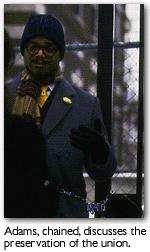Main Menu · Search · Current Issue · Contact · Archives · Centennial · Letters to the Editor · FAQs
![]()
Main Menu ·
Search · Current Issue · Contact · Archives · Centennial · Letters to the Editor · FAQs
![]()
| A Dean's Half Decade | Disunion, Continued |
| Harvard Portrait | Dreams Deferred |
| Front-Door Policy | Kroks Around the Clock |
| The Undergraduate | People in the News |
| Sports | The University |

![]()
And on the fifty-seventh day, approximately, they rested. Two months into the renovation of the Harvard Union, during the quiet spring-recess week, the silence deepened on March 27 as the clangorous construction ceased. Pending a hearing April 4, the work had been halted by a temporary restraining order issued by Middlesex Superior Court in response to an alumni lawsuit aimed at preserving the Union's Great Hall.
The hall figures prominently in the reconfiguration of the building as a humanities center (see "Concerning the Union, Disunion," March-April, page 74). The litigation capped an increasingly intensive-if not extensive-war of words over the project even as demolition proceeded. In the memory of Harvard historians, the only precedents for such actions by alumni against the University were the 1950s and '60s lawsuits opposing the move of the Arnold Arboretum's herbarium and library to Cambridge, and 1978 litigation by residents of Brookline, alumni among them, against construction of the Medical Area Total Energy Plant.
The events unfolded as follows. By late February, scaffolds surrounded the building. In early March, earthmoving equipment dug deep holes around the foundation. Construction crews razed the Prescott Street loading dock, through which supplies had been conveyed to the kitchen for the freshman dining hall, and began pushing interior debris out through the raw openings. But neither the visible start of construction-nor even naming the building Barker Hall, in honor of Robert R. Barker '36, a past president of the Board of Overseers, and his wife, Elizabeth, whose gifts will pay for more than half of the $25 million project's cost-stopped the controversy.
On February 15, the New York Times reported "Changes to Union Divide Harvard." The next day, Michael Adams, a historic preservationist from New York, chained himself to a gate by the Union and urged Harvard "to call off this act of vandalism." The Boston Globe weighed in editorially 10 days later on "Harvard marred".
There matters might have rested had not the School of Design's architecture faculty decided en masse to oppose the renovation. A letter from architecture chairman Jorge Silvetti to President Neil L. Rudenstine decried the "worrisomely philistine" attitude toward the Great Hall and warned of "the gravity of the disaster" in process. All this made the Globe's front page. The paper delighted in observing the intramural brawl extending along Quincy Street, from the Design School's austere concrete Gund Hall to the Union's richly embellished brick façade. Closed-door meetings ensued among architecture faculty, the president, and Jeremy R. Knowles, dean of the Faculty of Arts and Sciences.
From there, the debate escalated into a cultural war, Cambridge-style. The Globe ran an opinion column by H. A. Crosby Forbes '50, Ph.D. '61, secretary of the ad hoc Committee to Save the Great Hall of the Harvard Union ("Those who love Harvard and look to it for cultural leadership believe that even at this late hour the University will do the right thing…"), and another editorial ("Ignorance at Harvard") in mid-March.
Following which, on March 26, members of the committee, transmogrified into the Harvard Alumni Architectural Review Committee (HAARC), filed suit. Forbes said HAARC sought to have the renovation plans reviewed-something he felt Harvard had been unwilling to entertain-with an eye to revising them and restoring the hall.
By the time work stopped, the gutting of the building's interior was far advanced, and the roof had been cut open to make way for new dormers. University officials, who pointed to the multiyear process of planning the renovation (see "A Dean's Half-Decade," page 72) and the permits secured before construction began, were facing costs from the delay totaling thousands of dollars per day.
For all the fury, perhaps the soundest words on the affair were written by Robert Campbell '58, M.Arch. '67, the Globe's architecture critic. In an analysis published February 19, before the hostilities escalated, he noted that "The Great Hall is one terrific room," but in a "close call" concluded, "I can't imagine any future for this space, except as the pathetic, hollow stage set of a forgotten era. Neither the room itself, nor the purposes for which [Henry Lee] Higginson created it, have any meaning for the University of today or the foreseeable future."
Beyond the immediate debate, Campbell noted that in resolving architectural issues, "Other universities do better"-among them the University of Virginia, with its Architect to the University, and Princeton, with a standing committee-both charged with enhancing the character of their campuses. "Harvard," he urged, "should create an independent outside advisory board of qualified architects and historians, a group that could-among other services-help thrash out disputes before they become controversies."
A long-term goal of the lawsuit, Forbes said, was to bring an alumni architectural review board into being. Before the litigation, Harvard administrators, at least in private, seemed inclined to entertain Campbell's idea. Whether that spirit persists, now that the lawyers are involved, remains to be seen.
Main Menu ·
Search · Current Issue · Contact · Archives · Centennial · Letters to the Editor · FAQs
![]()